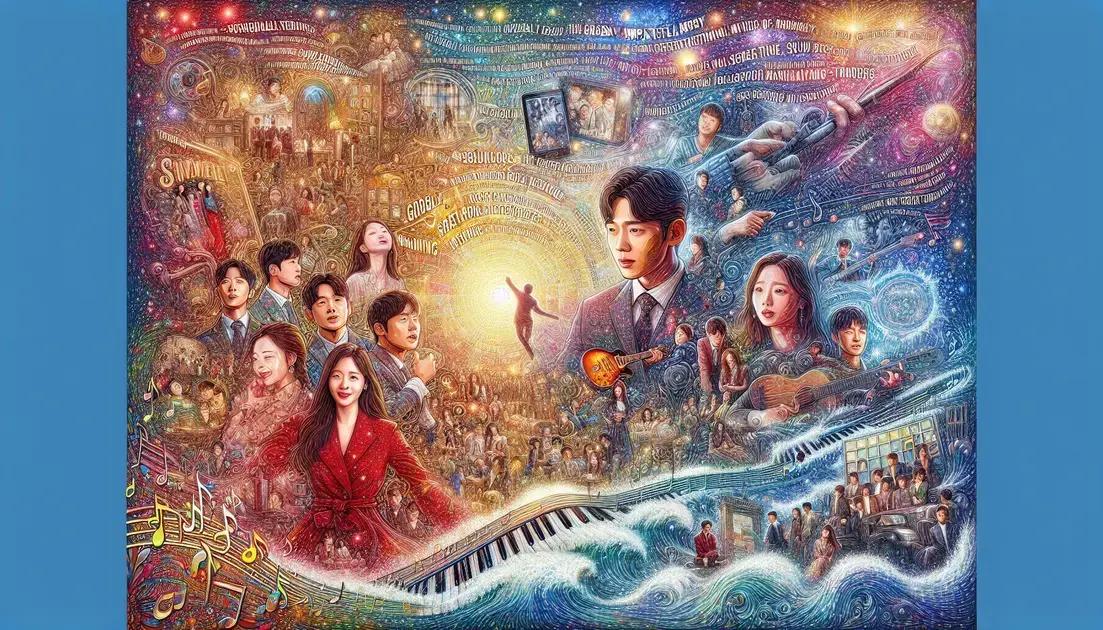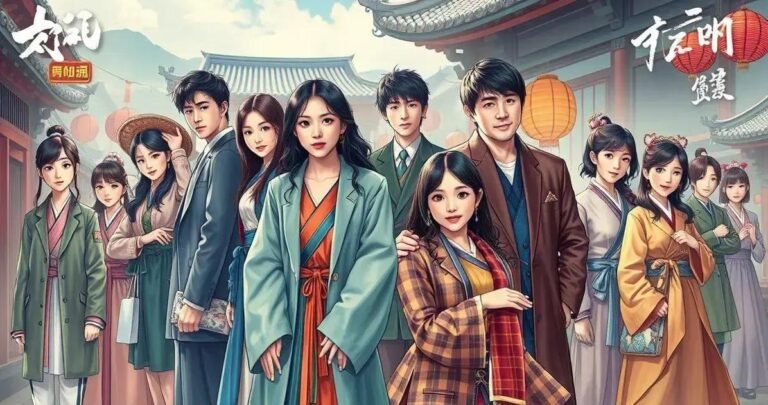The Best OSTs in K-Dramas: Unveiling Their Impact on the Music Industry
Anúncios
K-Dramas are not only celebrated for their gripping plots and stellar casts, but also for their **OSTs** that resonate around the world. From emotional ballads to upbeat tracks, these soundtracks play a pivotal role in enhancing the overall viewing experience, drawing in audiences globally. Discover how these compelling musical pieces have influenced the music industry and become cultural phenomena in their own right, unveiling talents of influential composers and setting trends in storytelling.
Unveiling the Charms of K-Drama OSTs
K-Drama OSTs are a delightful blend of melody, emotion, and narrative, creating unforgettable experiences for viewers. These soundtracks are meticulously crafted to complement the storyline, enhancing both dramatic and light-hearted moments. From heart-wrenching ballads to energetic pop tunes, each track is tailored to evoke specific emotions, making them integral to the storytelling process.
Connecting Audiences Worldwide
Moreover, K-Drama OSTs transcend language barriers, connecting audiences globally. Their universal appeal lies in the emotions they convey, often amplifying the cultural exchange and expanding the fan base beyond Asia. Through streaming platforms, these songs find their place in playlists worldwide, showcasing the global influence of K-Drama music.
Recognizable melodies often trigger memories of iconic scenes, allowing fans to relive their favorite moments. This replay value not only sustains the popularity of the drama but also boosts the careers of the artists involved. As a result, OSTs play a crucial role in the success and longevity of K-Dramas in the international entertainment landscape.
Collaboration with Renowned Artists
Collaborations with renowned artists and composers add another layer of charm to these OSTs. Such partnerships bring diversity and excitement to the soundtrack, drawing in music lovers and drama fans alike. Famous K-Pop idols, for instance, often lend their voices to these soundtracks, further blurring the lines between music and drama, and enhancing their appeal.
Historical Evolution of OSTs in K-Dramas

The evolution of OSTs in K-Dramas traces back to the early years of Korean television. Initially, these soundtracks were simple, featuring basic melodies that supported the plot. As Korean entertainment expanded, the demand for more intricate and engaging soundscapes grew, marking a shift in their musical landscape.
1990s: The Emergence of Signature Sounds
In the 1990s, K-Drama OSTs began to emerge as standalone works of art. Iconic dramas like ‘Winter Sonata’ introduced the world to signature melodies that were infectious and emotive. This era saw the rise of original background scores that flowed seamlessly with the narrative, captivating audiences.
With globalization, the popularity of K-Dramas surged, and so did the complexity of their soundtracks. By the 2000s, renowned composers started creating lush orchestral pieces and contemporary hits, giving K-Drama OSTs a distinct identity that mirrored the polished storytelling presented onscreen.
2010s Onwards: Globalization and Innovation
The last decade witnessed a remarkable surge in the international appeal of K-Dramas, thanks to the global success of soundtracks like ‘Goblin’ and ‘Descendants of the Sun’. These OSTs blended traditional Korean elements with modern genres, innovating the sound in ways that appealed to a diverse international audience and were chart-toppers globally.
Today, K-Drama OSTs continue to evolve, characterized by dynamic collaborations between K-Pop idols and iconic composers. This symbiotic relationship highlights the fusion of pop culture and narrative storytelling, broadening the appeal of both music and drama across cultural boundaries.
Impact of K-Drama OSTs on the Global Music Scene
The impact of K-Drama OSTs on the global music scene cannot be overstated. These soundtracks have propelled Korean music into the international spotlight, breaking language barriers and captivating diverse audiences. With the rise of streaming platforms, OSTs have reached listeners all around the world, charting on global music lists and showcasing the rich diversity of Korean soundscapes.
OSTs as Cultural Ambassadors
More than just background music, K-Drama OSTs serve as cultural ambassadors, blending traditional Korean elements with modern beats. This fusion has introduced international audiences to Korean culture, piquing interest in Korean language and traditions. As a result, these soundtracks are key contributors to the Korean Wave, known as Hallyu, which continues to grow stronger.
The collaboration between K-Drama producers and popular K-Pop idols has also amplified this impact. Songs performed by well-known idols help attract their fanbases to dramas, merging fandoms and expanding the fan community globally. Furthermore, these OSTs have led to successful international tours and concerts, where artists perform both their hits and popular drama soundtracks.
Innovating Genres Worldwide
K-Drama OSTs have inspired composers and musicians worldwide, encouraging them to explore innovative genres and styles. This creative exchange has resulted in a new wave of global sound fusions, encouraging artists to experiment with elements found in K-Drama music. Additionally, the emotional storytelling conveyed through these OSTs resonates with listeners, pushing the boundaries of how music and narrative intertwine on a global scale.
Influential Composers Behind Iconic K-Drama OSTs
![]()
The world of K-Drama OSTs is richly enhanced by the creative genius of its influential composers. These artists craft melodies that resonate with the audience, capturing emotions and portraying the story’s essence. Among the notable names, Yoon Il-sang stands out for his versatile compositions, adding layers of depth to the soundtracks of popular dramas like ‘The Heirs’ and ‘My Love from the Star’.
Collaborative Synergy
Seo Hyun-jin, another prolific composer, is celebrated for her ability to blend traditional and contemporary sounds. Her work on ‘Moon Lovers: Scarlet Heart Ryeo’ created a perfect harmony between the drama’s historical elements and its vibrant soundtrack, enriching the viewer’s experience.
Moreover, Nam Hye-seung has contributed immensely to the world of K-Drama OSTs. Her iconic scores for ‘Goblin’ and ‘Crash Landing on You’ are a testament to her talent for evoking emotional intensity through music. Collaborations with global artists and orchestras have helped her transcend cultural boundaries, leaving a lasting impact across the globe.
Crafting Timeless Classics
These influential composers not only write music but also weave stories within their notes, much like Lee Pil-ho does with his progressive musical scores. His contributions to series like ‘Descendants of the Sun’ reflect his ability to transform a scene with his profound understanding of musical narrative.
Their work is seminal in creating memorable viewing experiences, each composer bringing a unique voice to the soundtrack that marries beautifully with the drama’s visuals and story arcs, showcasing the power of music in storytelling.
How K-Drama OSTs Enhance Storytelling
K-Drama OSTs play a crucial role in enhancing storytelling, bringing narratives to life with their emotional depth and rich soundscapes. These soundtracks are meticulously synchronized with key scenes, amplifying the drama’s emotional resonance. Whether it’s a moment of love, tension, or sorrow, the music elevates the story, ensuring viewers are engrossed in the unfolding drama.
Deepening Emotional Connections
By embedding memorable melodies into pivotal scenes, OSTs create lasting emotional connections with the audience. The right song can evoke empathy, happiness, or suspense, drawing viewers deeper into the storyline. Such tracks often become synonymous with the drama, reminding fans of their favorite moments long after the series ends.
Moreover, K-Drama OSTs are designed to reflect the characters’ journeys. Compositions often mirror the protagonist’s inner world, subtly narrating their evolution and growth through the series. This musical storytelling enriches the narrative, providing viewers with a more immersive experience.
Enhancing Cultural Narratives
These soundtracks can also reflect cultural and thematic elements of the drama, introducing audiences to traditional Korean music and instruments. This adds authenticity and depth, allowing viewers from different backgrounds to appreciate Korean culture through sound. The blending of contemporary and traditional motifs demonstrates the versatility of these OSTs in storytelling.
The Future of OSTs in K-Dramas

The future of OSTs in K-Dramas is set to evolve with technological advancements and changing viewer preferences. As digital platforms become the primary medium for consuming entertainment, OSTs will likely become more interactive, allowing fans to engage with music in innovative ways. Streaming services could offer behind-the-scenes access, interactive playlists, and exclusive content tailored to individual preferences.
Adapting to New Musical Trends
K-Drama OSTs will continue to adapt to global music trends, integrating modern genres like electronic and indie pop. This will help keep the soundtracks fresh and relevant, attracting a newer audience while retaining their core fan base. Collaborations with international artists are expected to increase, bringing diverse influences into K-Drama music and fostering cultural exchange.
Artificial intelligence and data analytics will play a role in shaping future OSTs, helping composers predict popular trends and tailor soundtracks to enhance viewer engagement. Personalized musical experiences could become a norm, where viewers receive custom soundtracks based on their emotional responses and preferences.
Expanding Global Influence
As K-Dramas continue to gain popularity worldwide, their OSTs are poised to become significant cultural exports. These soundtracks will likely not only enrich stories but also serve as gateways to Korean culture, sparking interest and curiosity among international audiences. The global footprint of K-Drama music could lead to an expanded market for live performances and OST-centric events, showcasing the power of music as a universal language.
The Transformative Power of K-Drama OSTs
K-Drama OSTs have evolved beyond mere background scores, becoming pivotal in global storytelling. They enhance narratives, breathe life into characters, and deepen viewers’ emotional experiences. As seen in their historical evolution, their global impact continues to expand, welcoming diverse influences and pushing creative boundaries.
Influential composers play an essential role in crafting these memorable melodies, making each soundtrack a unique masterpiece. With technological advances and global collaborations, the future looks promising for these soundtracks, redefining how we experience drama and music across cultures.
Ultimately, K-Drama OSTs remain a compelling example of how music can transcend boundaries, promote cultural exchange, and unite audiences worldwide. Their ability to adapt and innovate ensures that they will continue to leave an indelible mark on the music industry.







